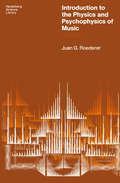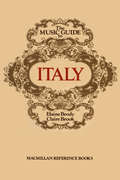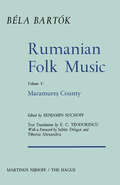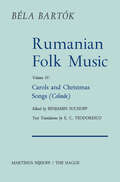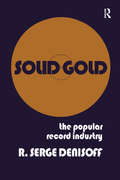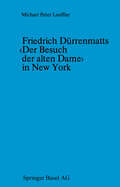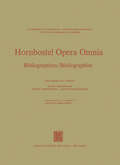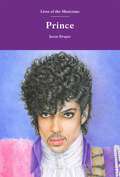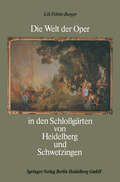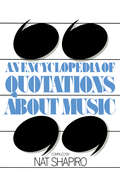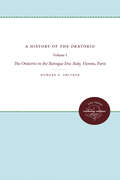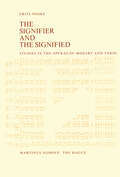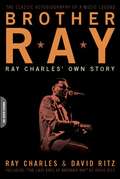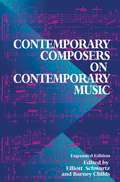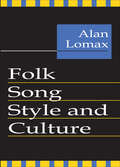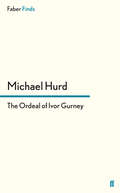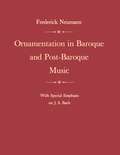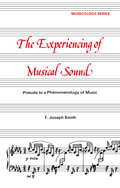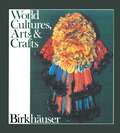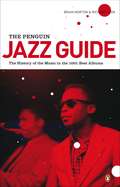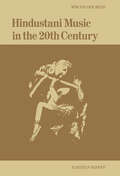- Table View
- List View
Introduction to the Physics and Psychophysics of Music (Heidelberg Science Library #Vol. 16)
by Juan G. RoedererRumanian Folk Music: Carols and Christmas Songs (Colinde) (Bartok Archives Studies in Musicology #4)
by Bela Bartokn the first volume of Rumanian Folk Music (Instrumental Melodies) I portions of Bela Bart6k's subsequently-discarded preface, concern ing the fate of his folklore publications, are presented in explanation of the editorial processes necessary for achieving the publication. 1 By way of introduction to this revised edition of a previous, although in complete, published version of the Rumanian Carols and Christmas Songs (Colinde), we refer again to the author's suppressed lines which pertain to this volume: The second publication by the same publisher was to include my collection of Rumanian Colindas (Winter-solstice songs). Their extremely interesting texts were supposed to appear in original as well as in English. After several years of delay, the translation to English prose was completed, one part in adequate archaic English, the rest (by someone else) in most unsuitable Kitchen-English. The publisher did not wish to change this, though. Result: I published the book at my own expense; however, only the musical part, because of lack of sufficient funds. The texts are still in manuscript, even today. 2 Our primary aim, therefore, has been to unite the Rumanian poetic texts and translations with the musical part, in one volume, as was the desire of the author.
Solid Gold: Popular Record Industry
by R. Serge DenisoffMore than 90 record companies release over 9,000 pop records each year-a staggering total of 52,000 songs. Each one competes for the gold record, the recording industry's symbol of success that certifies $1 million worth of records have been sold. Solid Gold explains why, for each record that succeeds, countless others fail. This book follows the progress of a record through production, marketing, and distribution, and shows how a mistake made at any point can mean its doom. Denisoff suggests that a drastic shift in the demographic makeup of the pop music audience during the sixties has resulted in a broader listening public, including fans at every level of society.
Solid Gold: Popular Record Industry
by R. Serge DenisoffMore than 90 record companies release over 9,000 pop records each year-a staggering total of 52,000 songs. Each one competes for the gold record, the recording industry's symbol of success that certifies $1 million worth of records have been sold. Solid Gold explains why, for each record that succeeds, countless others fail. This book follows the progress of a record through production, marketing, and distribution, and shows how a mistake made at any point can mean its doom. Denisoff suggests that a drastic shift in the demographic makeup of the pop music audience during the sixties has resulted in a broader listening public, including fans at every level of society.
Friedrich Dürrenmatts ‹Der Besuch der alten Dame› in New York: Ein Kapitel aus der Rezeptionsgeschichte der neueren Schweizer Dramatik
by LOEFFLERHornbostel Opera Omnia: Bibliographien / Bibliographies (Hornborstel Opera Omnia #2)
by K. P. Wachsmann D. Christensen H. P. ReineckePrince (Lives of the Musicians)
by Jason DraperHis name was Prince, and he was funky. He was also inspiring, infuriating, visionary and otherworldly. Channelling contradictions in search of his own unique truth, he eventually changed his name to an unpronounceable glyph that merged the male and female symbols in an outward expression of his inner dualities. Gifted with the ability to play almost every instrument on his records, and shifting between musical styles as much as he switched-up his looks, he refused to acknowledge boundaries. Instead, he brought opposing forces together in a life-long quest to reconcile a dirty mind with a love for God. In doing so, the mini Minneapolis genius became a world-conquering icon whose towering legacy continues to shape pop culture.
An Encyclopedia of Quotations About Music
by Nat ShapiroWriting about music-about what it is and what it means-is akin to describing the act of love. Somehow, the reduction of the experience to an unblushingly detailed exposition of how, where, when, and why who does what to whom, from prelude to resolu tion, loses everything in the translation. The other extreme, the one wherein the writer, in desperation, resorts to metaphor (with or without benefit of meter and rhyme), most often results in im agery that is banal, vulgar, inane, obscure, pretentious, and almost always insufferably romantic. To achieve good and accurate writing about music is as rare an accomplishment as expert wine-tasting, lion-taming, diamond-cut ting, truffie-finding and (if one just happens to be an unconverted Mohican brave) deer-tracking. Only the intuitive, the pure, the sensual, and the intrepid need apply. Professional musicians often evidence a fixed tendency either to rudely ignore or else to actively despise those of us who bravely try to understand, define, and describe their art. To many composers and instrumentalists, those outsiders (nonmusicians) who have the temerity to discuss anything more abstract than the digital dexterity of a fiddler, the particular vanity of a conductor, or the wage scales for overtime recording sessions are judged worthy only of contempt or-at the most-patronizing tolerance. "Music means itself," insists one of the contributors to the collection that follows, and many practitioners of the art of organ ized sound would prefer to leave it at that.
A History of the Oratorio: Vol. 1: The Oratorio in the Baroque Era: Italy, Vienna, Paris
by Howard E. SmitherHoward Smither has written the first definitive work on the history of the oratorio since Arnold Schering published his Geschichte des Oratoriums in 1911. This volume is the first of a four-volume comprehensive study that offers a new synthesis of what is known to date about the oratorio.Volume 1, divided into three parts, opens with the examination of the medieval, Renaissance, and early Baroque antecedents and origins of the oratorio, with emphasis on Rome and Philip Neri's Congregation of the Oratory and with special attention to the earliest works for which the term oratorio seems appropriate. The second part recounts the development of the oratorio in Italy, circa 1640-1720. It reviews the social contexts, patrons, composers, poets, librettos, and music of the oratorio in Italy, especially in Vienna and Paris. The procedure adapted throughout the work is to treat first the social context, particularly the circumstances of performance of the oratorio in a given area and period, then to treat the libretto, and finally the music. For each geographic area and period, the author has selected for special attention a few oratorios that appear to be particularly important or representative. He has verified the information offered in the specialized literature whenever possible by reference to the music or documents. In a number of areas, particular seventeenth-century Italy, in which relatively few previous studies have been undertaken or secondary sources have proven to be inadequate, the author has examined the primary sources in manuscript and printed form -- music, librettos, and documents of early oratorio history. Impressive research and intelligent integration of disparate elements make this complicated, diffuse subject both readable and accessible to the student of music.Volume 2, The Oratorio in the Baroque Era: Protestant Germany and England, and Volume 3, The Oratorio in the Classical Era, continue and expand the study of oratorio history. Although this series was originally announced as a three-volume study, Smither will conclude with a fourth volume.This new work--the first English-language study of the history of the oratorio will become the standard work on its subject and an enduring contribution to music and scholarship.Originally published in 1977.A UNC Press Enduring Edition -- UNC Press Enduring Editions use the latest in digital technology to make available again books from our distinguished backlist that were previously out of print. These editions are published unaltered from the original, and are presented in affordable paperback formats, bringing readers both historical and cultural value.
Music and the Brain: Studies in the Neurology of Music
by MACDONALD CRITCHLEY, R.A. HENSONMusic and the Brain: Studies in the Neurology of Music is a collaborative work that discusses musical perception in the context of medical science. The book is comprised of 24 chapters that are organized into two parts. The first part of the text details the various aspects of nervous function involved in musical activity, which include neural and mechanicals aspects of singing; neurophysiological interpretation of musical ability; and ecstatic and synesthetic experiences during musical perception. The second part deals with the effects of nervous disease on musical function, such as musicogenic epilepsy, the amusias, and occupational palsies. The book will be of great interest to students, researchers, and practitioners of disciplines that deal with the nervous system, such as psychology, neurology, and psychiatry.
The Signifier and the Signified: Studies in the Operas of Mozart and Verdi
by F. NoskeThe studies collected in this volume deal with the interpretation of opera. In most cases the results are based on structural analysis, a concept which may require some clarification in this context. During the past de cade 'structure' and 'structural' have become particularly fashionable terms lacking exact denotation and used for the most divergent purposes. As employed here, structural analysis is concerned with such concepts as 'relationship', 'coherence' and 'continuity', more or less in contrast to formal analysis which deals with measurable material. In other words, I have analysed the structure of an opera by seeking and examining factors in the musico-dramatic process, whereas analysts of form are generally preoccupied with the study of elements contained in the musical object. Though admittedly artificial, the dichotomy of form and structure may elucidate the present situation with regard to the study of opera. Today, nearly one hundred years after the death of Wagner, the proclaimed anti thesis of Oper und Drama is generally taken for what it really was: a means to propagate the philosophy of its inventor. The conception of opera (whether 'continuous' or composed of 'numbers') as a special form of drama is no longer contested. Nevertheless musical scholarship has failed to draw the consequences from this view and few scholars realize the need to study general theory of drama and more specifically the dramatic experience.
Brother Ray: Ray Charles' Own Story
by David Ritz Ray CharlesRay Charles (1930-2004) led one of the most extraordinary lives of any popular musician. In Brother Ray, he tells his story in an inimitable and unsparing voice, from the chronicle of his musical development to his heroin addiction to his tangled romantic life. Overcoming poverty, blindness, the loss of his parents, and the pervasive racism of the era, Ray Charles was acclaimed worldwide as a genius by the age of thirty-two. By combining the influences of gospel, jazz, blues, and country music, he invented, almost single-handedly, what became known as soul. And throughout a career spanning more than a half century, Ray Charles remained in complete control of his life and his music, allowing nobody to tell him what he could and couldn't do.As the Chicago Sun-Times put it, Brother Ray is "candid, explicit, sometimes embarrassing, often hilarious, always warm, touching and deeply human-just like his music."
Contemporary Composers On Contemporary Music (Music Reprint Ser. #1978)
by Elliott Schwartz Barney Childs Jim FoxThis anthology of essays, interviews, and autobiographical pieces provides an invaluable overview of the evolution of contemporary music-from chromaticism, serialism, and indeterminacy to jazz, vernacular, electronic, and non-Western influences. Featuring classic essays by Stravinsky, Stockhausen, and Reich, as well as writings by lesser-known but equally innovative composers such as Jack Beeson, Richard Maxfield, and T. J. Anderson, this collection covers a broad range of styles and approaches. Here you will find Busoni's influential "Sketch of a New Esthetic of Music"; Partch's exploration of a new notation system; Babbitt's defense of advanced composition in his controversial "Who Cares If You Listen?"; and Pauline Oliveros's meditations on sound. Now updated with fifteen new composers including Michael Tippet, György Ligeti, Gunther Schuller, Ben Johnston, Sofia Gubaidulina, and William Bolcom, this important book gathers together forty-nine pieces-many out of print and some newly written for this volume-which serve as a documentary history of twentieth-century music, in theory and practice. Impassioned, provocative, and eloquent, these writings are as exciting and diverse as the music they discuss.
Folk Song Style and Culture
by Alan LomaxSong and dance style--viewed as nonverbal communications about culture--are here related to social structure and cultural history. Patterns of performance, theme, text and movement are analyzed in large samples of films an recordings from the whole range of human culture, according to the methods explained in this volume. Cantometrics, which means song as a measure of man, finds that traditions of singing trace the main historic distributions of human culture and that specific traits of performance are communications about identifiable aspects of society. The predictable and universal relations between expressive communication and social organization, here established for the first time, open up the possibility of a scientific aesthetics, useful to planners.
Folk Song Style and Culture
by Alan LomaxSong and dance style--viewed as nonverbal communications about culture--are here related to social structure and cultural history. Patterns of performance, theme, text and movement are analyzed in large samples of films an recordings from the whole range of human culture, according to the methods explained in this volume. Cantometrics, which means song as a measure of man, finds that traditions of singing trace the main historic distributions of human culture and that specific traits of performance are communications about identifiable aspects of society. The predictable and universal relations between expressive communication and social organization, here established for the first time, open up the possibility of a scientific aesthetics, useful to planners.
The Ordeal of Ivor Gurney
by Michael HurdFirst published in 1978 The Ordeal of Ivor Gurney is a moving and extraordinary account of a tragic genius penned by the composer Michael Hurd. Born in Gloucester in 1890 Ivor Gurney began writing songs and poems in his teens, taking his inspiration from the Severn Valley countryside where he grew up. Sent to the Western Front during the First World War Gurney experienced desolation and horror that made a profound impression on him. He ended his days in an asylum, but at his death in 1937 he was beginning to be acknowledged as one of England's finest composers. Still, it took several more decades for his work as a war poet to be fully appreciated.'Hurd compresses into a taut, sympathetic outline the initial optimism and later torment of Gurney's ill-starred life... distinguished by its crisp use of poetic extracts.' PN Review
Ornamentation in Baroque and Post-Baroque Music, with Special Emphasis on J.S. Bach
by Frederick NeumannOrnaments play an enormous role in the music of the seventeenth and eighteenth centuries, and ambiguities in their notation (as well as their frequent omission in the score) have left doubt as to how composers intended them to be interpreted. Frederick Neumann, himself a violinist and conductor, questions the validity of the rigid principles applied to their performance. In this controversial work, available for the first time in paperback, he argues that strict constraints are inconsistent with the freedom enjoyed by musicians of the period.The author takes an entirely new look at ornamentation, and particularly that of J. S. Bach. He draws on extensive research in England, France, Germany, Italy, and the United States to show that prevailing interpretations are based on inadequate evidence. These restrictive interpretations have been far-reaching in their effect on style. By questioning them, this work continues to stimulate a reorientation in our understandiing of Baroque and post-Baroque music.
Experiencing of Musical Sound: A Prelude to a Phenomenology of Music (Musicology)
by F. J. SmithFirst Published in 1979. Routledge is an imprint of Taylor & Francis, an informa company.
Experiencing of Musical Sound: A Prelude to a Phenomenology of Music (Musicology)
by F. J. SmithFirst Published in 1979. Routledge is an imprint of Taylor & Francis, an informa company.
Kulturen Handwerk Kunst: Art, Artisanat et Société World Cultures, Arts and Crafts
by BAER HAUSER SEILER KAUFMANN RAMSEYER HAAS NABHOLZ BOSER GANTNERThe Penguin Jazz Guide: The History of the Music in the 1000 Best Albums
by Brian Morton Richard CookThe Penguin Guide to Jazz Recordings is firmly established as the world's leading guide to recorded jazz, a mine of fascinating information and a source of insightful - often wittily trenchant - criticism. This is something rather different: Brian Morton (who taught American history at UEA) has picked out the 1000 best recordings that all jazz fans should have and shows how they tell the history of the music and with it the history of the twentieth century. He has completely revised his and Richard Cook's entries and reassessed each artist's entry for this book. The result is an endlessly browsable companion that will prove required reading for aficionados and jazz novices alike.'It's the kind of book that you'll yank off the shelf to look up a quick fact and still be reading two hours later' Fortune'Part jazz history, part jazz Karma Sutra with Cook and Morton as the knowledgeable, urbane, wise and witty guides ... This is one of the great books of recorded jazz; the other guides don't come close' Irish Times
Hindustani Music in the 20th Century
by W. van der MeerAIM In spite of a reasonably extensive literature in English' and Indian vernaculars, there are extremely few books on Indian music that can be considered of a scientific standard. I found, when I took up an interest in Indian music in 1967, that even protracted reading of the studies in English was not conducive to an understanding of the principles of performance. Most of my study and research have been devoted to the gradual refinement of this very understanding. In the course of time it also became obvious that different scholars and different musicians held divergent views on many basic concepts of Indian music. Therefore, one of my tasks was to assess the degree of variability in Indian music. As a corollary I wanted to know how this variability could manifest itself as change in a relatively short and well-documented period. It is often assumed that traditional cultures, as e. g. in India, are rather inert and that the art forms hardly ever change. This study proves the contrary: Indian music has a strong vitality. If we examine the different treatises through the centuries this vitality would appear to be a basic characteristic. I felt that at least an effort to discover the roots of such change would be valuable as a contribution to the study of art history and possibly to the sociology of culture.
